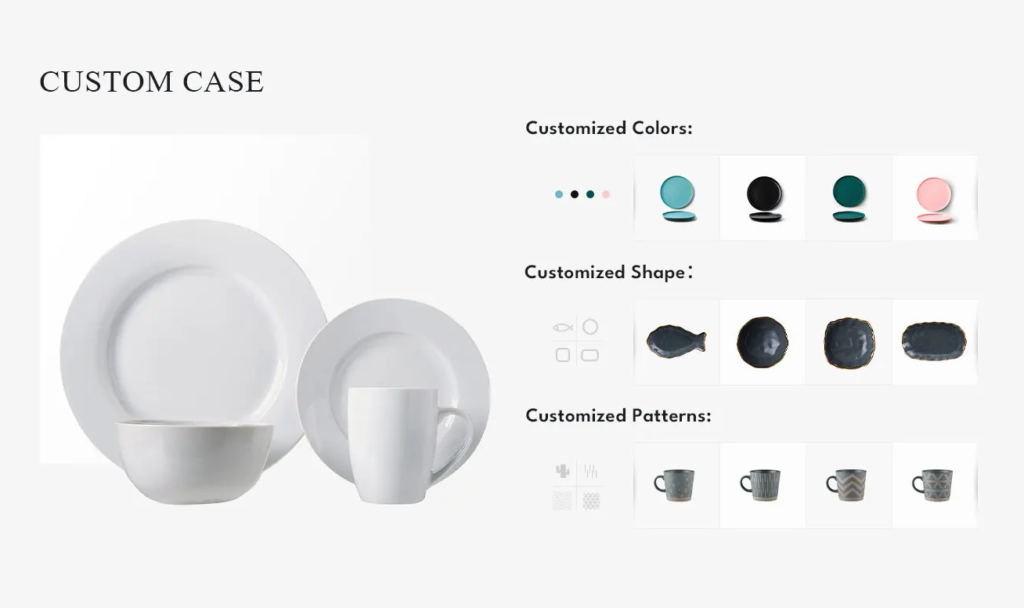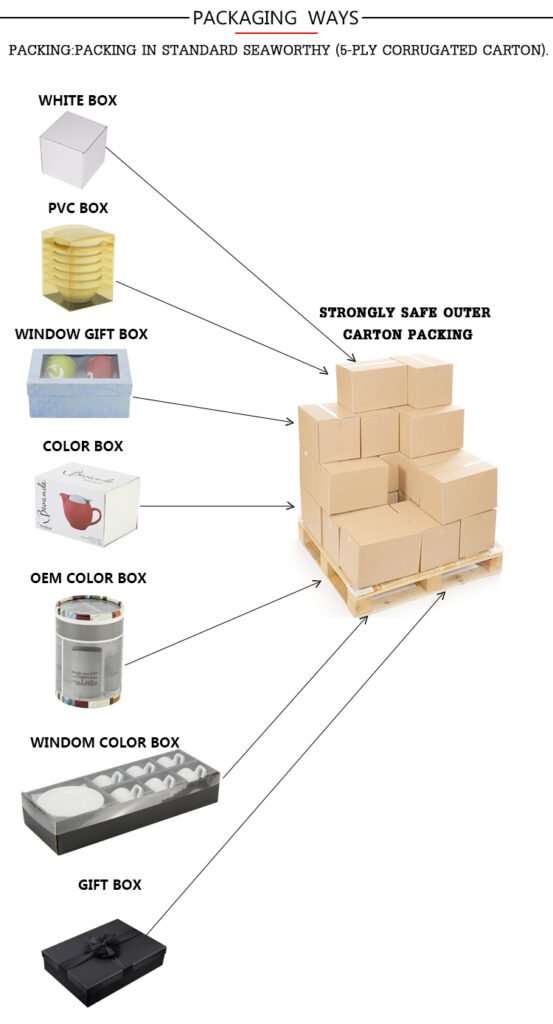Introduction
In today’s competitive dining industry, customized dinnerware can significantly enhance a restaurant’s ambiance, reflect a brand’s unique identity, or simply offer personalized touches for a special event. Whether you’re a restaurant owner, a retailer, or an event planner, custom dinnerware can be tailored to suit your exact needs and preferences. But with so many options available, how do you choose the right combination of features for your business?
In this guide, we’ll take you through everything you need to know when purchasing custom dinnerware. From choosing the ideal combination of plates and cups to selecting the right material and manufacturing process, we’ll provide a step-by-step approach to help you make informed decisions.
Eka ceramic have 10 years of experience in making ceramic planters. Our products are very eco-friendly and produced with the most advanced technology.
In the past few years customized dinnerware, there have been more and more small and medium-sized buyers looking for us to purchase customized, such as Amazon and other sellers of these e-commerce platforms.
Customized dinnerware usually appear in the peak purchasing season before December and around March every year.
Customized dinnerware in small quantities are becoming a purchasing trend, which can also better meet the needs of consumers, better test the market and save costs.
1. Determine the Tableware Combination
The first step in purchasing custom dinnerware is to decide on the exact combination of pieces you need. This will vary depending on the type of dining experience you offer, the cuisine, and the style of your establishment.
Common Tableware Components
A typical dinnerware set includes a range of items designed to serve different courses and beverages. Here’s a basic breakdown:
- Dinner plates: These are large plates used to serve the main course.
- Salad plates: Smaller plates for salads or appetizers.
- Soup bowls: Ideal for serving soups or stews.
- Bread plates: Small, round plates used for serving bread and butter.
- Dessert plates: Slightly smaller than dinner plates, typically used for cakes or pastries.
- Cups and saucers: Used for serving hot beverages like tea or coffee.

Custom Considerations
When purchasing custom dinnerware, you need to think about which pieces make sense for your specific needs. For example, a fine dining restaurant might require a full set that includes everything from soup bowls to dessert plates, whereas a casual café might only need plates, cups, and saucers. Here are a few points to consider:
- Cuisine: What types of dishes are you serving? If you specialize in pasta, soup bowls may not be necessary, but a variety of plate sizes will be essential.
- Portions: Consider the average portion sizes at your restaurant or event. Larger portions will require larger dinner plates and bowls.
- Dining Style: If your establishment is more casual, fewer pieces may be needed. However, a high-end restaurant may require a wider range of pieces to accommodate multiple courses.
Pro tip: Consult with your chef or event planner to determine which pieces will best showcase your menu and ensure a seamless dining experience.
2. Determine the Material of the Dinnerware
The material of your custom dinnerware can greatly impact the look, feel, and durability of the final product. The three most common materials used in dinnerware manufacturing are ceramic, porcelain, and bone china. Each has its unique properties and advantages.
Ceramic
Ceramic dinnerware is popular for its affordability and versatility. It can be produced in a wide range of colors, styles, and finishes, making it a great option for businesses that want flexibility in design. There are two primary types of ceramic: earthenware and stoneware.
- Earthenware: More porous and less durable than other materials, but it can offer a rustic, hand-crafted look. Earthenware is ideal for casual settings or themed restaurants.
- Stoneware: More durable than earthenware, stoneware offers a balance between casual and formal dining. It is less likely to chip and has a smoother finish.
Porcelain
Porcelain is known for its strength, durability, and fine appearance. It is fired at a higher temperature than ceramic, resulting in a denser, non-porous material. This makes it more resistant to wear and tear, which is ideal for high-traffic environments like restaurants and hotels. Porcelain is often associated with high-end dining due to its elegant appearance.
Bone China
Bone china is the most luxurious and delicate of the three materials. It is made with a combination of bone ash and fine clay, giving it a translucent quality that is highly prized in formal settings. Bone china is strong yet lightweight, making it perfect for upscale restaurants, fine dining events, or special occasions.
Choosing the Right Material
When choosing the material for your custom dinnerware, consider the following factors:
- Durability: Will the dinnerware be used frequently in a busy restaurant setting, or is it for occasional events? Porcelain and stoneware offer more durability, while bone china is more suited to formal occasions.
- Aesthetic: Each material has its own aesthetic appeal. Bone china offers a refined, translucent look, while ceramic and porcelain provide more versatility in terms of colors and finishes.
- Budget: Custom bone china will be more expensive than ceramic or porcelain, so factor in your budget when deciding.
Pro tip: Opt for porcelain or stoneware if you need something durable and versatile. If you’re looking for a more refined, high-end feel, consider bone china.
3. Choose the Manufacturing Process
Once you’ve selected your material, the next step is choosing the manufacturing process. The process used will affect the final appearance, durability, and overall quality of your custom dinnerware. Here are the main methods used in the production of dinnerware:
Hand-Crafted
Hand-crafted dinnerware is made by skilled artisans who shape, fire, and glaze each piece by hand. This process allows for a high level of customization and attention to detail. Each piece is unique, making it ideal for boutique restaurants, special events, or anyone looking for a personalized touch.
Pros:
- Each piece is unique.
- High level of customization.
- Often considered more prestigious.
Cons:
- More expensive due to the labor involved.
- Longer production time.
Machine-Made
Machine-made dinnerware is produced using automated processes that allow for mass production. This method is faster and more cost-effective, making it ideal for businesses that require a large volume of dinnerware. While customization is still possible, the level of detail may not be as high as with hand-crafted options.
Pros:
- More affordable.
- Faster production time.
- Ideal for large-scale orders.
Cons:
- Less customization.
- May lack the uniqueness of hand-crafted pieces.
Custom Decoration
In addition to the basic manufacturing process, you’ll also need to choose how your dinnerware will be decorated. Common techniques include glazing, hand-painting, and decal application.
- Glazing: A layer of liquid glass is applied to the surface of the dinnerware, giving it a glossy or matte finish. This also makes the dinnerware more durable and resistant to stains.
- Hand-Painting: Skilled artisans can hand-paint designs onto the dinnerware, allowing for intricate and unique designs.
- Decal Application: This process involves transferring pre-made designs onto the dinnerware. Decals are a cost-effective way to apply logos, patterns, or images.
Pro tip: If you’re looking for a unique, artistic look, opt for hand-crafted or hand-painted options. If you need large quantities at a lower cost, machine-made with decal application may be the way to go.
4. Choose Colors That Match Your Local Market
Color choice is crucial when designing custom dinnerware, as it can influence the perception of your brand and dining experience. The right colors can enhance the presentation of food and create a cohesive look for your restaurant or event. When choosing colors, consider the preferences of your local market and target audience.
Cultural Significance
Colors have different meanings in different cultures, so it’s important to choose colors that resonate with your target market. For example:
In Western cultures, white is often associated with cleanliness and purity, making it a popular choice for dinnerware.
In Asian cultures, red is a symbol of luck and prosperity, so it might be a good choice for a celebratory setting.
Earth tones like brown, beige, and green are commonly associated with nature and sustainability, which might appeal to eco-conscious customers.
Trend Analysis
It’s also essential to stay current with market trends. If bold colors and geometric patterns are trending in your region, incorporating these into your custom designs can help your dinnerware stand out.
Matching with Your Brand
Your dinnerware should complement the overall aesthetic of your brand. For example, a minimalist café might choose sleek white or black plates, while a vibrant, eclectic restaurant could opt for brightly colored or patterned dishes.
Pro tip: When in doubt, stick to neutral colors like white, cream, or light gray, which are versatile and work well with various types of food.
5. Determine the Method of Packing and Transportation
Finally, once your custom dinnerware is designed and produced, it’s time to think about how it will be packaged and transported. Proper packing is essential to ensure that the dinnerware arrives safely and intact, especially if you’re ordering in bulk from overseas.
Packaging Materials
Dinnerware is fragile, so it’s crucial to use high-quality packaging materials. Consider the following options:
- Foam or bubble wrap: These materials provide cushioning and help prevent chips or cracks during transit.
- Custom boxes: Design custom-fit boxes for each piece of dinnerware to minimize movement during shipping.
- Wooden crates: For large or international shipments, wooden crates provide extra protection and reduce the risk of damage.

Transportation Options
Depending on the size of your order and where it’s being shipped from, you’ll need to choose between air freight or sea freight.
Air freight: Faster but more expensive. This option is ideal for smaller, time-sensitive orders.
Sea freight: More cost-effective for large orders, but it takes longer.
Pro tip: For international shipments, ensure that your packaging complies with import regulations to avoid any delays or additional costs.
Conclusion
Purchasing custom dinnerware involves more than just selecting a design. By carefully considering the tableware combination, material, manufacturing process, color scheme, and packaging, you can create a unique and durable product that enhances your brand and dining experience.
Custom dinnerware is a worthwhile investment that allows you to showcase your style, enhance your restaurant’s aesthetic, and provide a memorable dining experience for your customers. Take the time to evaluate your options and work with a reputable supplier to ensure the highest quality for your custom dinnerware.
Welcome to contact us
Email: info@ekaceramic.com
WhatsApp: +86-13829019946

